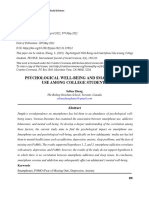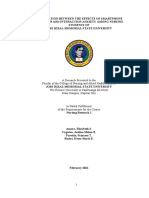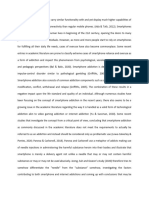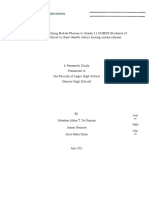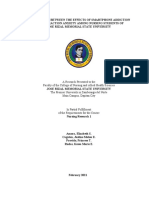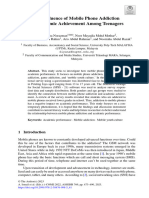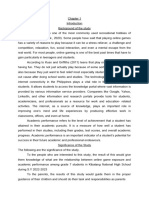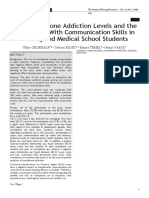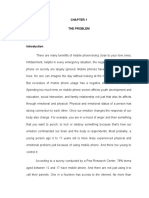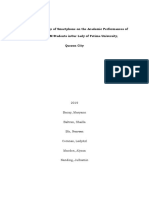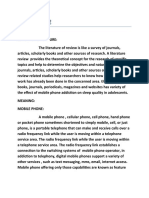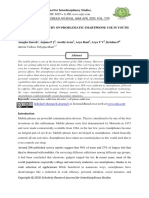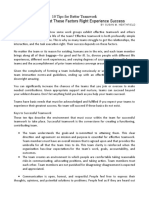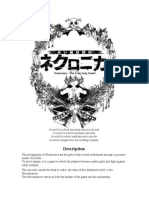A CORRELATIONAL STUDY ON THE MOBILE DEPENDENCE AND
PSYCHOLOGICAL WELL-BEING OF ST. MARY’S COLLEGE
OF TAGUM, INC. SENIOR HIGH SCHOOL
GRADE 12 STUDENTS
____________________
A Research Presented to the Senior High School Program
St. Mary’s College of Tagum, Inc.
Tagum City, Davao del Norte
____________________
In Partial Fulfilment of the Requirements for the
Research 2: Quantitative Research
Grade 12 STEM
____________________
YASMIN SANDARA SILVAN TUMANDA
EAUCLYDE JETHRO NERI CUCHARO
JHON LLOYD CASIPONG ESTEBAN
KENT KUAN CHEW CARTONEROS
JHON LUTHER MONJAS PANTUA
ZAILEE ROSE AGUILAR MEDINA
ALTHEA JHED MAGBANUA PIT
JENNYCA CASTILLON SILLEZA
NURSIBA MANSUL WARADJI
CHRIS JARVEY LIM AMPER
NICOLE SARINO
July 2021
� Chapter 1
THE PROBLEM AND ITS SETTING
Background of the Study
Nowadays, the emergence of new technologies in the field of Information and
Communications Technology (ICT) has resolved numerous communication and
information-related issues, paving the way for quick access to the most up-to-date news
and information and ushered in a new era of social communication. One of these
technologies is the mobile phone, which has grown exponentially in popularity worldwide,
with the number of subscribers in some countries exceeding the population. Additionally,
technology has developed into a concept that transcends communication and has become
ingrained in human life. In some instances, its excessive use and obsessive-compulsive
application have had adverse effects despite their numerous benefits; smartphones
provide instant gratification and may predispose individuals to smartphone addiction,
negatively affecting their health and well-being.
In a survey made by the China Internet Network Information Center in 2019, it is
stated that 98.6% of internet users in the country use mobile phones to access the internet
in 2018, which has made an increase of 1.1% over the previous year. In China, people aged
10 to 39 years old contributed for 67.8% of all online consumers, with students (25.4%)
being the most prominent user category (CNNIC, 2019). Mental health is mediated by
cognitive emotion preoccupation. Excessive phone use leads to emotional and cognitive
fixation with behavioral patterns (Cao et al., 2018). As a result of such behavior patterns,
a strong desire to use a mobile phone develops (Zheng and Lee, 2016). This extended use
of the mobile phone leads to the development of strong emotions and emotional
attachments, which leads to depression and, as a result, a decline in their well-being
(Zhou, 2019).
� According to Ching et al. (2015), 46.9 percent of Malaysian students are addicted
to their smartphones. This figure indicated that they are becoming more dependent on
their smartphones in their daily lives. University students in Malaysia are prone to
smartphone addiction and are vulnerable to anxiety and depression (Ithnai et al., 2018).
There is a need to develop potential health education programs and interventions
appropriate for dealing with addiction in university students and improving their mental
well-being.
Smartphones have become a necessity in our current era; people and individuals,
particularly students, have become somewhat reliant on smartphones. According to a
study conducted among high school students in the Philippines, students misuse their
phones daily, leading to addiction and negatively impacting their mental or psychological
well-being (Buctot et al., 2021). Fear of missing out (FOMO), nomophobia, and academic
performance are some of the effects of smartphones on a student's psychological well-
being.
In a study conducted at Panabo City, Davao del Norte, Paray et al. (2020) stated
that mobile phone dependency influences the respondents' health status. Problematic
mobile phone use, exposure to blue light before bedtime, or other unmeasured
confounding factors could impact the quality of life. It demonstrates and presents that it
is neither too harsh nor too critical in terms of health, but it still has minor consequences
and side effects, particularly in terms of well-being.
Mobile dependence on past studies is thought to be correlated with psychological
well-being. Most studies on this topic found a connection between these two variables;
however, none of these studies were conducted in Tagum City, Davao del Norte.
Furthermore, the researchers wanted to discover students' personal feelings and
interpretations of how dependent they are on their mobile devices. Such a finding may
provide more insight into the problematic use of the devices and how they felt individually.
� The focus of this research is to replicate and expand on previous findings and fill
knowledge gaps regarding indicators and predictors of problematic mobile dependency.
This study is to know if there is a correlation between students' mobile dependence and
psychological well-being. Furthermore, this study will define the reactions and how they
will feel about the proposed research.
Statement of the Problem
This study explored the relationship between mobile dependence and
psychological well-being among Grade 12 senior high school students in Saint Mary's
College of Tagum Inc. in Tagum, Davao del Norte Division for the SY: 2020-2021.
Specifically, the following objectives were formulated:
1. What is the level of students’ mobile dependence?
2. What is the extent of senior high school students’ psychological well-being?
3. Is there a relationship between the mobile dependence and psychological well-
being of students?
Hypotheses
The following hypotheses were formulated and were tested at 0.05 level of
significance.
1. There is no significant relationship between mobile dependence and psychological
well-being of students.
� References
Buctot, D. B., Kim, N., & Kim, S. H. (2021). Personal Profiles, Family Environment,
Patterns of Smartphone Use, Nomophobia, and Smartphone Addiction across
Low, Average, and High Perceived Academic Performance Levels among High
School Students in the Philippines. International Journal of Environmental
Research and Public Health, 18(10), 5219.
https://doi.org/10.3390/ijerph18105219
Cao X., Masood A., Luqman A., Ali A. (2018). Excessive use of mobile social networking
sites and poor academic performance: antecedents and consequences from
stressor-strain-outcome perspective. Comput. Hum. Behav. 85, 163–174.
10.1016/j.chb.2018.03.023
Ching SM, Yee A, Ramachandran V, et al. (2015). Validation of a Malay version of the
smartphone addiction scale among medical students in Malaysia. PLoS ONE
2015;10(10):1-11.
CNNIC (2019). Statistical Report on Internet Development in China. CNNIC.
https://www.cnnic.cn/hlwfzyj/hlwxzbg/hlwtjbg/201902/P02019031852302975
6345.pdf (accessed June 27, 2019).
Ithnai N., Ghazali S. E., Jaafar N. (2018). Relationship between smartphone addiction
with anxiety and depression. Relationship between Smartphone Addiction with
Anxiety and Depression among Undergraduate Students in Malaysia, 8(1), 164.
https://iptk.moh.gov.my/images/technical_report/INT-JOURNAL-OF-
HEALTH-SCIENCE-RESEARCH---SMARTPHONE-ADDICTION.pdf
Paray, M., Tanquiamco, D., Espinosa, S. K. K., Borlio, J., & Van Buladaco, M. (2020). A
correlational study on nomophobia and physical health of Panaboans across age
groups. International Journal of Research and Innovation in Social Science, 4(6),
256–262.
Zheng X., Lee M. K. O. (2016). Excessive use of mobile social networking sites: negative
consequences on individuals. Comput. Hum. Behav. 65, 65–76.
10.1016/j.chb.2016.08.011
Zhou B. (2019). Fear of missing out, feeling of acceleration, and being permanently online:
a survey study of University students' use of mobile apps in China. Chin. J.
Commun. 12, 66–83. 10.1080/17544750.2018.1523803

